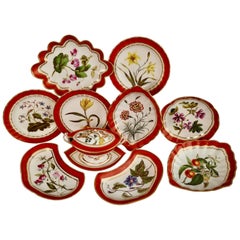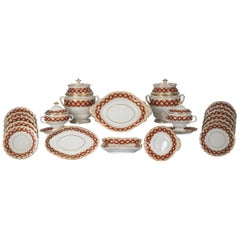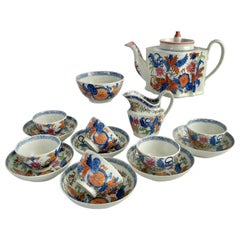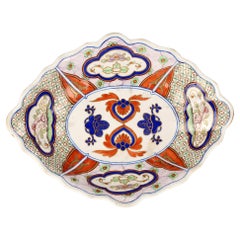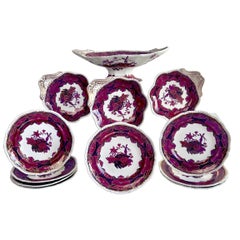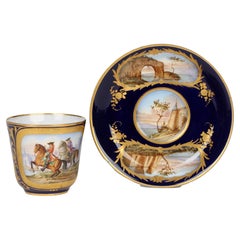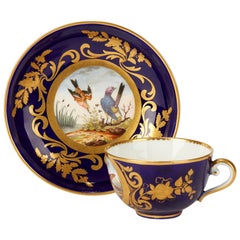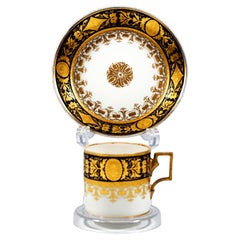1790s Porcelain
to
5
25
637
2,207
3,735
963
998
1,334
816
135
69
247
271
90
190
350
262
268
66
11
3
1
25
25
1
1
16
9
22
15
13
4
3
25
25
25
7
3
2
1
1
Period: 1790s
Antique Signed 18th Century Sevres Porcelain Floral Cornflower Cup & Saucer
Located in Philadelphia, PA
A fine antique French porcelain cup & saucer pair.
By Sevres.
In a blue Cornflower pattern.
Each with blue floral decoration with gilt accents to the rim, footrim, and body. The saucer also with a pink flower to its center.
Marked 'Bo' - likely for painter Henry-Germain Boileau fils.
Circa 1792.
Fully marked to the base of each.
Simply a wonderful Sevres cup and saucer...
Category
French Neoclassical Antique 1790s Porcelain
Materials
Porcelain
Derby Porcelain Part Dessert Service, Red Botanical, John Brewer, 1795-1800
By Crown Derby, John Brewer
Located in London, GB
This is a stunning part-dessert service made by Derby between about 1795 and 1800, painted with named botanical studies by John Brewer. The service consists of a lidded sauce comport on a stand, two kidney shaped dishes, two lozenge shaped dishes, one lozenge shaped low footed comport...
Category
English George III Antique 1790s Porcelain
Materials
Porcelain
$9,200 Sale Price / set
33% Off
Derby Pair of Cache Pots, Yellow, Flowers by William Billingsley, ca 1795
Located in London, GB
This is a pair of cache pots made by the Derby Porcelain Company in 1795. The pair is decorated in bright canary or "Scarsdale" yellow and a white band with large flowers painted by ...
Category
English George III Antique 1790s Porcelain
Materials
Porcelain
$1,940 Sale Price
20% Off
Extensive English Porcelain Dessert Service, Flight and Barr, circa 1792
Located in New York, NY
Pair of covered fruit coolers and liners, pair of covered sauce tureens on stands, 1 fruit compote, 4 lozenge-shape dishes, pair of square dishes, 4 shell-shaped dishes, 22 plates.
Category
English Antique 1790s Porcelain
Materials
Porcelain
New Hall Porcelain Tea Service, Japanese Tobacco Pattern, Georgian, circa 1795
By New Hall
Located in London, GB
This is a stunning tea service made by New Hall in circa 1795. The service is made of hybrid hard paste porcelain and decorated in a bold Chinoiserie pattern of large flower sprays. The service consists of a teapot with cover, a milk jug, a slop bowl, and six tea bowls with saucers.
This service has provenance; it came from the collection of David Redstone, the well known porcelain expert who wrote leading books on Bow and Chelsea porcelain.
The New Hall factory started as a cooperative of several Staffordshire potters making use of the porcelain license of Bristol Porcelain...
Category
English George III Antique 1790s Porcelain
Materials
Porcelain
$2,320 Sale Price / set
20% Off
Derby Porcelain Georgian Rare Hand Painted Dish
By Derby
Located in Bishop's Stortford, Hertfordshire
A rare and unusual Georgian Derby Porcelain dish finely hand painted colored enamels dating from around 1790. The oval shaped dish has a raised scalloped rim and is hand painted with...
Category
English George III Antique 1790s Porcelain
Materials
Porcelain
Pair 18 C. Sevres Porcelain Faux Porphyry Vases w/ Blue Script Sevres R.F. Mark
Located in New York, NY
An Incredible and Very Rare Pair of 18th Century Sevres Porcelain Faux Porphyry Vases with Blue Script Sevres R.F. Marks. Each features a classic form with flared necks and bulbous ...
Category
French Louis XVI Antique 1790s Porcelain
Materials
Porcelain
Sevres Porcelain Trembleuse Cup and Saucer First Size
Located in Tunbridge Wells, GB
Heading : 18th Century Sevres 1st Size Trembleuse Cup and Saucer
Date : Late 18th Century c1790
Marks : Interlaced L mark in blue. Incised OO mark on b...
Category
French Antique 1790s Porcelain
Materials
Porcelain
Chinese Late 18th Century Bowl
Located in Tampa, FL
An exceptional late 18th century Chinese porcelain bowl, richly decorated with a finely detailed court scene. The quality of painti...
Category
Japanese Antique 1790s Porcelain
Materials
Porcelain
18th Century English Pearlware Coffee Pot, circa 1795
Located in Nantucket, MA
18th Century English Pearlware Coffee Pot, circa 1795, a Staffordshire pottery coffee pot in an unusual, very large size, with transfer blue and w...
Category
English Chinoiserie Antique 1790s Porcelain
Materials
Porcelain
Derby Porcelain Botanical Comport Pattern 216 c1795
By Derby
Located in Tunbridge Wells, GB
Heading : Derby Porcelain botanical comport pattern 216
Date : c1795
Period : George III
Marks :Double China Hollyhock above Derby Crown and Crossed Swords and pattern number 216
Ori...
Category
British George III Antique 1790s Porcelain
Materials
Porcelain
$1,445 / item
Meissen Charger with Decoration a Flower Bunches, Marcolini Period Ca. 1800
Located in CH
Meissen charger with decoration a flower Bunches, Marcolini period Ca. 1800
This large Meissen Charger is decorated with a stylized bouquets of flower...
Category
German Neoclassical Antique 1790s Porcelain
Materials
Porcelain
German Meissen 'Marcolini' Porcelain Tea and Coffee Service, circa 1790
Located in New York, NY
Comprising coffee pot, tea pot, covered cream jug, covered sugar, ten tea cups, six coffee cups, 16 saucers.
Category
German Antique 1790s Porcelain
Materials
Porcelain
A Lowestoft Porcelain Basket of Scalloped Oval Form c1790
Located in Tunbridge Wells, GB
Heading : A Lowestoft Porcelain Basket of Scalloped oval form
Date : 1780- 1800
Period : George III
Marks :None
Origin : Lowestoft. Suffolk.
Colour :Blue and White
Pattern : Printed...
Category
British Georgian Antique 1790s Porcelain
Materials
Porcelain
Derby Porcelain Plates, Pattern 126, Painted by William Longden, Set of Six
By Derby
Located in Downingtown, PA
The beautiful and stylish Derby porcelain set of six plates are painted by William Longden with fruit within a heart-shaped gilt border. The fruit depicted include grapes, plums, str...
Category
English Georgian Antique 1790s Porcelain
Materials
Porcelain
Derby Square Dish, Camden Service, William Billingsley Roses on Green, 1795
By Derby
Located in London, GB
This is a very rare square dish from the famous "Earl of Camden" service made by the Derby Porcelain Company in 1795. The service was painted with typical English roses by William Billingsley, one of Britain's most famous painters, and responsible for exactly this type of rose painting on British porcelain.
There are more items available in this pattern, see separate listings. To keep these items together we'd be happy to offer a discount on multiple purchases - please ask!
The Derby Porcelain Company, later called Royal Crown Derby, is currently the oldest British porcelain factory still in production. The Derby pottery was one of the most prominent potteries right from the start of English porcelain production in the mid 1700s to today, and the factory went through many iterations. In the 1820s, it was called "Bloor Derby" as it came under the ownership of Robert Bloor; this factory later closed but its legacy was continued under the ownership of a group of employees, and later this was merged into a new factory called Royal Crown Derby, which is still in operation today and still carries forward some of the oldest patterns that have made it famous over the centuries.
William Billingsley was a brilliant but notoriously difficult man who left behind a trail of debts, broken hearts and mystery - but he was also one of the most important people in the history British porcelain. Billingsley revolutionised the way British decorators painted flowers; he added a freedom and artistry that now singles out British flower painting, and he created a new technique for painting roses, which you can see in this design. Billingsley worked at Derby, Worcester and Mansfield. He also set up his own potteries in Pinxton and Nantgarw and created some of the best porcelain ever made, but racking up great debts, before running off in the dead of night and ending his days at Coalport painting flowers.
Items painted by William Billingsley are rare and very much in demand - together with Thomas Baxter's work they are probably among the most desired pieces of British porcelain.
The Earl of Camden service was a huge service ordered by Lady Camden in 1795. It had to be produced under great, and unrealistic, time pressure and was notoriously late, much to Lady Camden's chagrin. She wanted the service to be produced by only the best artisans and therefore William Billingsley was tasked with painting all items - but it is thought that when it was clear the deadline was impossible to make, he enlisted the help of John Brewer for some of the last items, such as the ice pails. This plate shows the typical "Billingsley" roses: a beautiful naturally flowing garland of English roses interspersed with buds, trailing around a crisp gilt ribbon. The way the roses link into each other, the way each individual one is completely different, the light effects achieved by rubbing out some of the pink paint, and the very fine buds and foliage all point to these being from Billingsley's hand.
This dish came together with a plate that bears labels that point to a rich provenance: the Doris Wheatley Collection, the Daniel Collection, Derek Gardner...
Category
English George III Antique 1790s Porcelain
Materials
Porcelain
Antique French Sevres Oval Porcelain Dish, Late 18th Century
Located in London, GB
This is an important decorative antique French Sevres oval porcelain dish, the rear with underglaze blue interlaced LL factory Sevres mark, late 18th centu...
Category
French Antique 1790s Porcelain
Materials
Porcelain
Caughley Dish, Harlequin Pattern in Style of Donegall Service, ca 1793
Located in London, GB
This is a beautiful and intriguing porcelain dish made by Caughley and decorated at Chamberlains Worcester in or shortly after 1793. The dish has a "harlequin" pattern with six diffe...
Category
English Neoclassical Antique 1790s Porcelain
Materials
Porcelain
$1,120 Sale Price
20% Off
Flight Worcester Teapot Set, Monochrome Print "Ruins" Pattern, Georgian ca 1790
Located in London, GB
This is a beautiful set of a teapot, a sucrier with cover, and a plate made by Worcester in its Flight period, around 1790. You can tell from the generous size of the teapot that it ...
Category
English George III Antique 1790s Porcelain
Materials
Porcelain
$1,276 Sale Price / set
20% Off
Derby Oval Dish, Camden Service, William Billingsley Roses on Green, 1795 (2)
By Derby
Located in London, GB
This is a very rare oval lobed dish from the famous "Earl of Camden" service made by the Derby Porcelain Company in 1795. The service was painted with typical English roses by William Billingsley, one of Britain's most famous painters, and responsible for exactly this type of rose painting on British porcelain.
There are more items available in this pattern, see separate listings. To keep these items together we'd be happy to offer a discount on multiple purchases - please ask!
The Derby Porcelain Company, later called Royal Crown Derby, is currently the oldest British porcelain factory still in production. The Derby pottery was one of the most prominent potteries right from the start of English porcelain production in the mid 1700s to today, and the factory went through many iterations. In the 1820s, it was called "Bloor Derby" as it came under the ownership of Robert Bloor; this factory later closed but its legacy was continued under the ownership of a group of employees, and later this was merged into a new factory called Royal Crown Derby, which is still in operation today and still carries forward some of the oldest patterns that have made it famous over the centuries.
William Billingsley was a brilliant but notoriously difficult man who left behind a trail of debts, broken hearts and mystery - but he was also one of the most important people in the history British porcelain. Billingsley revolutionised the way British decorators painted flowers; he added a freedom and artistry that now singles out British flower painting, and he created a new technique for painting roses, which you can see in this design. Billingsley worked at Derby, Worcester and Mansfield. He also set up his own potteries in Pinxton and Nantgarw and created some of the best porcelain ever made, but racking up great debts, before running off in the dead of night and ending his days at Coalport painting flowers.
Items painted by William Billingsley are rare and very much in demand - together with Thomas Baxter's work they are probably among the most desired pieces of British porcelain.
The Earl of Camden service was a huge service ordered by Lady Camden in 1795. It had to be produced under great, and unrealistic, time pressure and was notoriously late, much to Lady Camden's chagrin. She wanted the service to be produced by only the best artisans and therefore William Billingsley was tasked with painting all items - but it is thought that when it was clear the deadline was impossible to make, he enlisted the help of John Brewer for some of the last items, such as the ice pails. This plate shows the typical "Billingsley" roses: a beautiful naturally flowing garland of English roses interspersed with buds, trailing around a crisp gilt ribbon. The way the roses link into each other, the way each individual one is completely different, the light effects achieved by rubbing out some of the pink paint, and the very fine buds and foliage all point to these being from Billingsley's hand.
This dish came together with a plate that bears labels that point to a rich provenance: the Doris Wheatley Collection, the Daniel Collection, Derek Gardner...
Category
English George III Antique 1790s Porcelain
Materials
Porcelain
Derby Lobed Dish, Camden Service, William Billingsley Roses on Green, 1795 (1)
By Derby
Located in London, GB
This is a very rare oval lobed dish from the famous "Earl of Camden" service made by the Derby Porcelain Company in 1795. The service was painted with typical English roses by William Billingsley, one of Britain's most famous painters, and responsible for exactly this type of rose painting on British porcelain.
There are more items available in this pattern, see separate listings. To keep these items together we'd be happy to offer a discount on multiple purchases - please ask!
The Derby Porcelain Company, later called Royal Crown Derby, is currently the oldest British porcelain factory still in production. The Derby pottery was one of the most prominent potteries right from the start of English porcelain production in the mid 1700s to today, and the factory went through many iterations. In the 1820s, it was called "Bloor Derby" as it came under the ownership of Robert Bloor; this factory later closed but its legacy was continued under the ownership of a group of employees, and later this was merged into a new factory called Royal Crown Derby, which is still in operation today and still carries forward some of the oldest patterns that have made it famous over the centuries.
William Billingsley was a brilliant but notoriously difficult man who left behind a trail of debts, broken hearts and mystery - but he was also one of the most important people in the history British porcelain. Billingsley revolutionised the way British decorators painted flowers; he added a freedom and artistry that now singles out British flower painting, and he created a new technique for painting roses, which you can see in this design. Billingsley worked at Derby, Worcester and Mansfield. He also set up his own potteries in Pinxton and Nantgarw and created some of the best porcelain ever made, but racking up great debts, before running off in the dead of night and ending his days at Coalport painting flowers.
Items painted by William Billingsley are rare and very much in demand - together with Thomas Baxter's work they are probably among the most desired pieces of British porcelain.
The Earl of Camden service was a huge service ordered by Lady Camden in 1795. It had to be produced under great, and unrealistic, time pressure and was notoriously late, much to Lady Camden's chagrin. She wanted the service to be produced by only the best artisans and therefore William Billingsley was tasked with painting all items - but it is thought that when it was clear the deadline was impossible to make, he enlisted the help of John Brewer for some of the last items, such as the ice pails. This plate shows the typical "Billingsley" roses: a beautiful naturally flowing garland of English roses interspersed with buds, trailing around a crisp gilt ribbon. The way the roses link into each other, the way each individual one is completely different, the light effects achieved by rubbing out some of the pink paint, and the very fine buds and foliage all point to these being from Billingsley's hand.
This dish came together with a plate that bears labels that point to a rich provenance: the Doris Wheatley Collection, the Daniel Collection, Derek Gardner...
Category
English George III Antique 1790s Porcelain
Materials
Porcelain
Chinese Tulipiere With A Four Character Qianglong Mark
Located in Kent, Dover
A Chinese tulipiere of bulbous form in hand painted blue and white porcelain. the underside has a four-character Qianlong mark in the Kaishu script.
Category
Chinese Antique 1790s Porcelain
Materials
Porcelain
Chinese Export Porcelain Handleless Tea Bowl and Saucer, Chinese Imari Pattern
Located in West Palm Beach, FL
Late eighteenth century Chinese Export Porcelain handleless tea bowl and saucer referred to as "Chinese Imari". Hand decorated in iron red, underg...
Category
Chinese Chinese Export Antique 1790s Porcelain
Materials
Enamel
Royal Copenhagen, Nine Antique and Rare Cups in Hand Painted Porcelain
Located in København, Copenhagen
Royal Copenhagen. Nine antique and rare cups in hand painted porcelain. Museum Quality, 1790s.
Measures: 6.5 x 4 cm.
In very good condition.
Stamped.
Category
Danish Antique 1790s Porcelain
Materials
Porcelain
English Porcelain Sauce Tureen, Cover, Ladle and Dish, Derby, circa 1790
Located in New York, NY
In the "Smith's Blue" ground, the oval tureen with scroll handles and foliate scroll loop finial, the dish of lobed oval form, painted with scattered flowe...
Category
English Antique 1790s Porcelain
Materials
Porcelain
Related Items
Spode Imperial China Dessert Service, Frog Pattern in Mauve, Regency circa 1828
By Spode
Located in London, GB
This is a very striking part dessert service made by Spode in about 1828, which is the Regency era. It is made of Spode's Imperial China and has the Frog pattern in mauve/purple. It consists of a high footed comport...
Category
English Regency Antique 1790s Porcelain
Materials
Ironstone
$1,380 Sale Price / set
20% Off
H 1 in W 1 in D 1 in
Sevres Hand Painted Matched Porcelain Cabinet Cup and Saucer
Located in Bishop's Stortford, Hertfordshire
A fine antique French matched hand painted porcelain cabinet cup and saucer painted with various scenes by Sevres and dating from the latter 19th century. ...
Category
French Late Victorian Antique 1790s Porcelain
Materials
Porcelain
$575 Sale Price / set
25% Off
H 2.47 in Dm 4.93 in
French Faience Cache Pot, 19th Century
Located in Doylestown, PA
A white glazed French Faience “Cache Pot” with handles, circa 1870.
Category
French French Provincial Antique 1790s Porcelain
Materials
Faience
Vintage Concrete Cache Pot
Located in Schellebelle, BE
Elegant ,Vintage concrete planter in the form of a flower,
very fine sculpting and design,
highly decorative piece with great color and patina
Category
French Vintage 1790s Porcelain
Materials
Concrete
Set of 12 English Raised Gilt Porcelain Dinner Service Plates
Located in Lambertville, NJ
A regal set of 12 elaborately gild service plates, by Royal Worcester. The set with delicate broad gilt borders with a white porcelain background. The mark on the back from 1950.
Category
American Vintage 1790s Porcelain
Materials
Porcelain
18th Century Japanese Imari Gold Porcelain Small Lobbed Cups and Saucers
Located in Delft, NL
18th century Japanese Imari Gold porcelain small lobbed cups and saucers
Early 18th century imari gold lobbed Japanese cups and saucers
Small cups and saucers...
Category
Japanese Antique 1790s Porcelain
Materials
Porcelain
$2,067 / set
H 1.23 in Dm 1.58 in
Ikat Porcelain Dessert Plates - Set of 6, Made in Italy
Located in ROCCAVIVARA CB, IT
Ikat patterns are an integral part of our colorful world, celebrating the beauty of this timeless design. Inspired by its rich heritage, we’ve transformed some of our most iconic Ikat designs into a vibrant porcelain plate collection. Handmade in Italy, this set of 6 plates is perfect for adding a joyful, playful touch to your tableware collection or as stunning decorative wall pieces. These plates are designed to bring elegance and delight to every dining experience.
Made in Italy
100% Porcelain
Hand-applied decal
Set of 6 Ikat Plates...
Category
Italian Other 1790s Porcelain
Materials
Porcelain
Minton Mazarine Extensive Pristine Dinner Service Cobalt Blue & Gold 232 Pcs
By Minton
Located in Great Barrington, MA
It's always time to entertain! This is one of the most elegant and versatile patterns imaginable in a Classic and rare Minton cobalt blue pattern wi...
Category
English Neoclassical Vintage 1790s Porcelain
Materials
Porcelain
$68,500 / set
H 0.75 in Dm 10.75 in
1930's Bauer Pottery Arts & Crafts Ceramic Yellow Ringware Flower Pot Jardinière
Located in San Juan Capistrano, CA
1930s Bauer Los Angeles Size 9 1/2 Yellow Ringware Ceramic Flower Pot.
Category
American Arts and Crafts 1790s Porcelain
Materials
Pottery
$445
H 9.5 in W 11 in D 11 in
Black Dragon, Six Contemporary Porcelain Dessert Plates with Decorative Design
By Vito Nesta
Located in Milano, Lombardia
Black Dragon pool is a collection of plates and vases inspired by the famous Chinese pond of the same name, located in the scenic Jade Spring Park. The de...
Category
Italian 1790s Porcelain
Materials
Porcelain
$354 / set
H 0.4 in Dm 8.27 in
Sevres Porcelain Trembleuse Cup and Saucer First Size
Located in Tunbridge Wells, GB
Heading : 18th Century Sevres 1st Size Trembleuse Cup and Saucer
Date : Late 18th Century c1790
Marks : Interlaced L mark in blue. Incised OO mark on b...
Category
French Antique 1790s Porcelain
Materials
Porcelain
Large Pair of Fine Carved Porcelain Jars with Covers
Located in New York, NY
A pair of fine carved soft white porcelain jars with covers, fish swimming in the stylish wave decorations.
Category
Vintage 1790s Porcelain
Previously Available Items
Sèvres French Porcelain Hand Painted Teacup and Saucer with Bird Scenes, 1791
Located in Bishop's Stortford, Hertfordshire
An exceptional and rare Sèvres Porcelain cabinet teacup and saucer each hand painted with birds within a landscape in coloured enamels and set...
Category
French Louis XVI Antique 1790s Porcelain
Materials
Porcelain
Viennese Imperial Porcelain Collecting Cup, Cobalt and Gold, Sorgenthal, 1799
Located in Vienna, AT
Cylindrical white cup, the upper part wrapped in a cobalt blue band as a background for delicate gold painting: oval medallions and diamond surrounded by dense feather and berry tend...
Category
Austrian Empire Antique 1790s Porcelain
Materials
Porcelain
Derby Plate, Camden Service, William Billingsley Roses on Green, 1795
By Derby
Located in London, GB
This is a very rare plate from the famous "Earl of Camden" service made by the Derby Porcelain Company in 1795. The service was painted with typical English roses by William Billingsley, one of Britain's most famous painters, and responsible for exactly this type of rose painting on British porcelain.
There are more items available in this pattern, see separate listings. To keep these items together we'd be happy to offer a discount on multiple purchases - please ask!
The Derby Porcelain Company, later called Royal Crown Derby, is currently the oldest British porcelain factory still in production. The Derby pottery was one of the most prominent potteries right from the start of English porcelain production in the mid 1700s to today, and the factory went through many iterations. In the 1820s, it was called "Bloor Derby" as it came under the ownership of Robert Bloor; this factory later closed but its legacy was continued under the ownership of a group of employees, and later this was merged into a new factory called Royal Crown Derby, which is still in operation today and still carries forward some of the oldest patterns that have made it famous over the centuries.
William Billingsley was a brilliant but notoriously difficult man who left behind a trail of debts, broken hearts and mystery - but he was also one of the most important people in the history British porcelain. Billingsley revolutionised the way British decorators painted flowers; he added a freedom and artistry that now singles out British flower painting, and he created a new technique for painting roses, which you can see in this design. Billingsley worked at Derby, Worcester and Mansfield. He also set up his own potteries in Pinxton and Nantgarw and created some of the best porcelain ever made, but racking up great debts, before running off in the dead of night and ending his days at Coalport painting flowers.
Items painted by William Billingsley are rare and very much in demand - together with Thomas Baxter's work they are probably among the most desired pieces of British porcelain.
The Earl of Camden service was a huge service ordered by Lady Camden in 1795. It had to be produced under great, and unrealistic, time pressure and was notoriously late, much to Lady Camden's chagrin. She wanted the service to be produced by only the best artisans and therefore William Billingsley was tasked with painting all items - but it is thought that when it was clear the deadline was impossible to make, he enlisted the help of John Brewer for some of the last items, such as the ice pails. This plate shows the typical "Billingsley" roses: a beautiful naturally flowing garland of English roses interspersed with buds, trailing around a crisp gilt ribbon. The way the roses link into each other, the way each individual one is completely different, the light effects achieved by rubbing out some of the pink paint, and the very fine buds and foliage all point to these being from Billingsley's hand.
The piece has a rich provenance; it bears labels from the Doris Wheatley Collection, the Daniel Collection, Derek Gardner...
Category
English George III Antique 1790s Porcelain
Materials
Porcelain
Chinese pair of mounted Trompet-shaped Pink Porcelaine Vases ormolu
Located in Valladolid, ES
A pair of mounted trumpet-shaped porcelain vases decorated in famille rose enamels,Rocaille-style gilt bronze mounting.
A sensational pair of Chinese trumpet-shaped vases in pink fam...
Category
French Baroque Antique 1790s Porcelain
Materials
Ormolu
Chamberlain's Worcester Dessert Service Kylin / Dragons in Compartments, ca 1795
Located in London, GB
This is an spectacular and very rare 27-piece dessert service made by Chamberlain's in Worcester around 1795. The service is decorated with the famous "Kylin" or "Dragons in Compartm...
Category
English George III Antique 1790s Porcelain
Materials
Porcelain
H 1 in W 1 in D 1 in
Derby Porcelain Coffee Can and Saucer, White with Gilt Georgian, circa 1795
By Derby
Located in London, GB
This is a beautiful coffee can with saucer made by Derby in about 1795. The can has a simple but sophisticated gilt pattern on a white ground.
The Derby Porcelain factory has its ...
Category
English Regency Antique 1790s Porcelain
Materials
Porcelain
Dessert Plate Chamberlains Worcester, Independence Pattern, ca 1795 '2'
Located in London, GB
This is a stunning dessert plate made by Chamberlains Worcester in about 1795. This is a plate of an original "Independence Service". The decoration is done in a "Japan" style with e...
Category
English Regency Antique 1790s Porcelain
Materials
Porcelain
Chamberlains Worcester Dessert Plate, Independence Pattern, ca 1795 '1'
Located in London, GB
This is a stunning dessert plate made by Chamberlains Worcester in about 1795. This is a plate of an original "Independence Service". The decoration is done in a "Japan" style with e...
Category
English Regency Antique 1790s Porcelain
Materials
Porcelain
Derby Orphaned Coffee Can, White, Landscape by Zachariah Boreman, ca 1790
By Derby
Located in London, GB
This is a very rare and stunning little orphaned coffeecup made by Derby in about 1790. The cup has a white ground, simple gilt rims and a stunning named mountain landscape painted by Zachariah Boreman.
The Derby factory, later reshaped into Royal Crown Derby, is currently the oldest British porcelain factory still in production. Derby was one of the most prominent potteries right from the start of English porcelain production in the mid 1700s to today. Their items are of exceptionally high quality and many of the designs have become iconic, particularly the Imari designs; many of these are still being made today. Derby made many exciting designs in the Regency era, and this cup, which would have belonged to a large tea service, is a beautiful example. The marking at the underside indicates that the cup was produced some time between 1782 and 1800, however the style is from the mid-1790s.
Zachariah Boreman was one of the most celebrated painters at Derby. He arrived at Derby around 1774 after working at Chelsea, and remained until 1794, when he left in frustration with Michale Kean, the owner. Even though Boreman became one of the prime landscape painters at Derby, Kean would not pay him more and this caused Boreman to go back to London and work for the Simms decorating studio. Boreman was most probably influenced by Paul Sandby, the chief drawing...
Category
English Georgian Antique 1790s Porcelain
Materials
Porcelain
Flight & Barr Teapot on Stand, White with Purple Flower Sprays, Georgian ca 1792
Located in London, GB
This is a beautiful teapot on a stand, made by Flight & Barr in or shortly after 1792. The items are in the "twisted shanked" shape and decorated with a simple yet sophisticated deco...
Category
English Georgian Antique 1790s Porcelain
Materials
Porcelain
H 8 in W 9.75 in D 4 in
Wedgwood Antique Three Color Jasperware Medallion Vase
Located in Bishop's Stortford, Hertfordshire
A rare Wedgwood three color jasperware beaker shaped vase applied with portrait medallions dating from circa 1790. The vase stands on a rounded fo...
Category
English Georgian Antique 1790s Porcelain
Materials
Porcelain
Flight & Barr Worcester Teacup Trio, Cobalt Blue Gilt Thistle Pattern, ca 1792
Located in London, GB
This is a beautiful "true trio" consisting of a teacup, a coffee cup and a saucer, made by Flight & Barr in about 1792. The items are in the "twisted shanked" shape and decorated wit...
Category
English Georgian Antique 1790s Porcelain
Materials
Porcelain
Recently Viewed
View AllMore Ways To Browse
Kakiemon Plate
Magnolia Plate
Haviland Porcelain Hand Painted Plates
Minton Cobalt Blue
Imperial Service Plates
Meissen Coffee Cup
Meissen Fruit
Meissen Gardeners Children
Imprisoned Glass
Limoges Cobalt Blue With Gold
Meissen Cabinet
Meissen Capture
Meissen Coffee Cup And Saucer
German Christmas Angel
Hermes Cup
Meissen Putti
Minton Birds
Italian Florentine Porcelain

